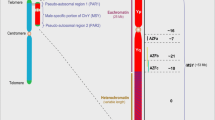Abstract
Mouse Td ho (Tattered-Hokkaido) was described as being allelic with Td in our previous study. Both allelic genes, which are located at the same position on the centromere of the X Chromosome (Chr), generate similar phenotypes such as male embryonic lethality, and in heterozygous females, hyperkeratotic skin, skeletal abnormalities, and growth retardation. The emopamil binding protein gene (Ebp) emerged as a candidate for mouse Td ho mutation, since the Td gene was recently determined to result from a point mutation of Ebp. In this study, Ebp cDNA of Td ho was demonstrated to possess double point mutations that cause two amino acid changes from Leu to Pro at position 132 and from Ser to Cys at 133 in EBP protein. EBP participates in cholesterol biosynthesis, and cholest-8(9)-en-3β-ol was found to be increased in the plasma of Td ho adult females but not in that of normal mice. From these results, a loss of function was expected for the EBP protein encoded by Td ho . Both the phenotypes and genes responsible for Td ho as well as Td are quite similar to those of human X-linked chondrodysplasia punctata (CDPX2).
Similar content being viewed by others
Author information
Authors and Affiliations
Additional information
Received: 9 January 2001 / Accepted: 1 April 2001
Rights and permissions
About this article
Cite this article
Seo, K., Kelley, R., Okano, S. et al. Mouse Td ho abnormality results from double point mutations of the emopamil binding protein gene (Ebp). Mammalian Genome 12, 602–605 (2001). https://doi.org/10.1007/s00335-001-3010-1
Published:
Issue Date:
DOI: https://doi.org/10.1007/s00335-001-3010-1




